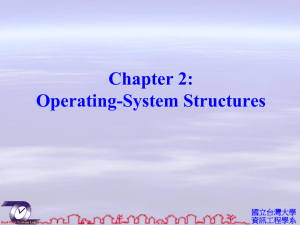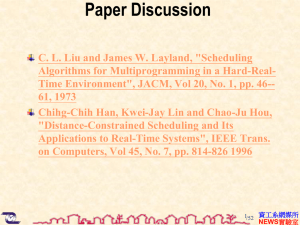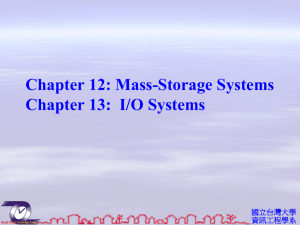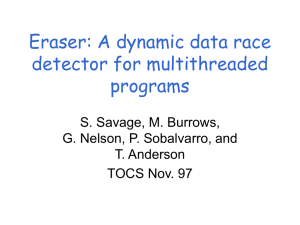資工系網媒所NEWS實驗室Module 6
advertisement
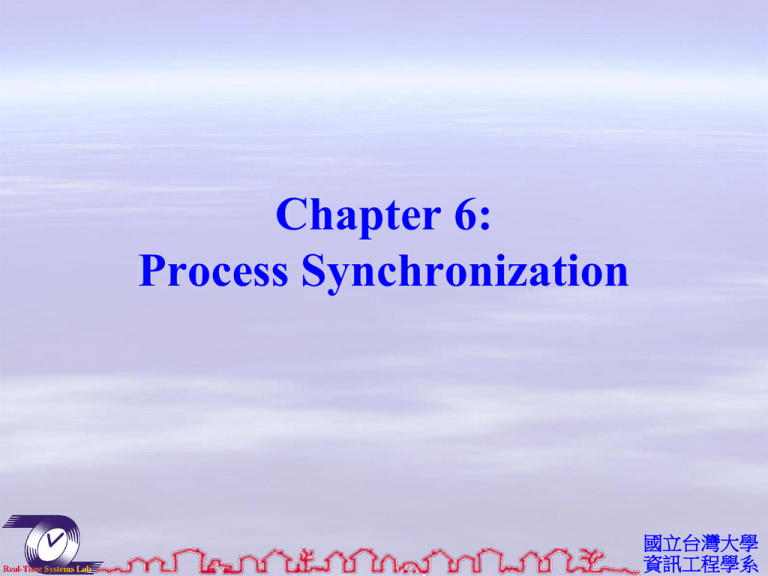
Chapter 6:
Process Synchronization
國立台灣大學
資訊工程學系
Objectives
To introduce the critical-section problem,
whose solutions can be used to ensure
the consistency of shared data
To present both software and hardware
solutions of the critical-section problem
To examine several classical processsynchronization problems.
To explore several tools that are used to
solve process synchronization problems.
1 /76
資工系網媒所
NEWS實驗室
Module 6: Process Synchronization
Background
The Critical-Section Problem
Peterson’s Solution
Synchronization Hardware
Mutex locks
Semaphores
Classic Problems of Synchronization
Monitors
Synchronization Examples
Alternative Approaches
2 /76
資工系網媒所
NEWS實驗室
Background
Concurrent access to shared data may result in data inconsistency
Maintaining data consistency requires mechanisms to ensure the
orderly execution of cooperating processes
Suppose that we wanted to provide a solution to the consumerproducer problem that fills all the buffers. We can do so by having
an integer count that keeps track of the number of full buffers.
Initially, count is set to 0. It is incremented by the producer after it
produces a new buffer and is decremented by the consumer after it
consumes a buffer.
3 /76
資工系網媒所
NEWS實驗室
Producer
Consumer
while (true) {
while (true) {
/* produce an item and put in
nextProduced */
while (count == BUFFER_SIZE)
; // do nothing
buffer [in] = nextProduced;
in = (in + 1) % BUFFER_SIZE;
count++;
}
while (count == 0)
; // do nothing
nextConsumed = buffer[out];
out = (out + 1) % BUFFER_SIZE;
count--;
/* consume the item in
nextConsumed */
}
4 /76
資工系網媒所
NEWS實驗室
Race Condition
count++ could be implemented as
register1 = count
register1 = register1 + 1
count = register1
count-- could be implemented as
register2 = count
register2 = register2 - 1
count = register2
Consider this execution interleaving with “count = 5” initially:
S0: producer execute register1 = count
S1: producer execute register1 = register1 + 1
S2: consumer execute register2 = count
S3: consumer execute register2 = register2 - 1
S4: producer execute count = register1
S5: consumer execute count = register2
{register1 = 5}
{register1 = 6}
{register2 = 5}
{register2 = 4}
{count = 6 }
{count = 4}
5 /76
資工系網媒所
NEWS實驗室
Solution to Critical-Section Problem
1. Mutual Exclusion - If process Pi is executing in its critical section, then
no other processes can be executing in their critical sections
2. Progress - If no process is executing in its critical section and there
exist some processes that wish to enter their critical section, then the
selection of the processes that will enter the critical section next cannot
be postponed indefinitely
3. Bounded Waiting - A bound must exist on the number of times that
other processes are allowed to enter their critical sections after a
process has made a request to enter its critical section and before that
request is granted
Assume that each process executes at a nonzero speed
No assumption concerning relative speed of the N processes
6 /76
資工系網媒所
NEWS實驗室
Algorithm (1) for Process Pi Pj
do {
do {
while (turn != i) ;
while (turn != j) ;
critical section
critical section
turn = j;
remainder section
} while (1);
turn = i;
remainder section
} while (1);
7 /76
資工系網媒所
NEWS實驗室
Algorithm (2) for Process Pi Pj
do {
flag[i] = TRUE;
while (flag[j]) ;
critical section
flag[i] = false;
remainder section
} while (1);
do {
flag[j] = TRUE;
while (flag[i]) ;
critical section
flag[j] = false;
remainder section
} while (1);
8 /76
資工系網媒所
NEWS實驗室
Peterson’s Solution
Two-process solution
Assume that the LOAD and STORE instructions are
atomic; that is, cannot be interrupted.
The two processes share two variables:
int turn;
Boolean flag[2]
The variable turn indicates whose turn it is to enter the
critical section.
The flag array is used to indicate if a process is ready to
enter the critical section. flag[i] = true implies that process
Pi is ready!
9 /76
資工系網媒所
NEWS實驗室
Algorithm (3) for Process Pi Pj
while (true) {
flag[i] = TRUE;
turn = j;
while ( flag[j] && turn == j);
while (true) {
flag[j] = TRUE;
turn = i;
while ( flag[i] && turn == i);
CRITICAL SECTION
}
CRITICAL SECTION
flag[i] = FALSE;
flag[j] = FALSE;
REMAINDER SECTION
REMAINDER SECTION
}
10 /76
資工系網媒所
NEWS實驗室
Synchronization Hardware
Many systems provide hardware support for
critical section code
Uniprocessors – could disable interrupts
Currently running code would execute without
preemption
Generally too inefficient on multiprocessor systems
Operating systems using this not broadly scalable
Modern machines provide special atomic
hardware instructions
Atomic = non-interruptable
Either test memory word and set value
Or swap contents of two memory words
11 /76
資工系網媒所
NEWS實驗室
Solution to Critical-section Problem Using Locks
do {
acquire lock
critical section
release lock
remainder section
} while (TRUE);
12 /76
資工系網媒所
NEWS實驗室
TestAndndSet Instruction
Definition:
boolean TestAndSet (boolean *target)
{
boolean rv = *target;
*target = TRUE;
return rv:
}
13 /76
資工系網媒所
NEWS實驗室
Solution using TestAndSet
Shared boolean variable lock., initialized to false.
Solution:
while (true) {
while ( TestAndSet (&lock ))
; /* do nothing
// critical section
lock = FALSE;
//
remainder section
}
14 /76
資工系網媒所
NEWS實驗室
Swap Instruction
Definition:
void Swap (boolean *a, boolean *b)
{
boolean temp = *a;
*a = *b;
*b = temp:
}
15 /76
資工系網媒所
NEWS實驗室
Solution using Swap
Shared Boolean variable lock initialized to FALSE;
Each process has a local Boolean variable key.
Solution:
while (true) {
key = TRUE;
while ( key == TRUE)
Swap (&lock, &key );
// critical section
lock = FALSE;
//
remainder section
}
16 /76
資工系網媒所
NEWS實驗室
Bounded-waiting Mutual Exclusion with
TestandSet()
do {
waiting[i] = TRUE;
key = TRUE;
while (waiting[i] && key)
key = TestAndSet(&lock);
waiting[i] = FALSE;
// critical section
j = (i + 1) % n;
while ((j != i) && !waiting[j])
j = (j + 1) % n;
if (j == i)
lock = FALSE;
else
waiting[j] = FALSE;
// remainder section
} while (TRUE);
17 /76
資工系網媒所
NEWS實驗室
Mutex Locks
Mutual exclusion
A process must acquire the lock before entering a critical section
It release the lock when it exits the critical section
A variable available: indicate if the lock is available
do {
acquire(S) {
while (!available)
acquire lock
; /* busy wait */
critical section
available = false;
release lock
}
remainder section
release() {
} while (TRUE);
available = true;
}
18 /76
資工系網媒所
NEWS實驗室
Semaphore
Synchronization tool that does not require busy waiting
Semaphore S – integer variable
Two standard operations modify S: wait() and signal()
Originally called P() and V()
Less complicated
Can only be accessed via two indivisible (atomic) operations
wait (S) {
while S <= 0
; // no-op
S--;
}
signal (S) {
S++;
}
19 /76
資工系網媒所
NEWS實驗室
Semaphore as General Synchronization Tool
Counting semaphore – integer value can range over an
unrestricted domain
Binary semaphore – integer value can range only between 0
and 1; can be simpler to implement
Also known as mutex locks
Can implement a counting semaphore S as a binary semaphore
Provides mutual exclusion
Semaphore mutex; // initialized to 1
do {
wait (mutex);
// critical Section
signal (mutex);
// remainder section
} while (TRUE);
20 /76
資工系網媒所
NEWS實驗室
Semaphore Implementation
Must guarantee that no two processes can execute
wait () and signal () on the same semaphore at the
same time
Thus, implementation becomes the critical section
problem where the wait and signal code are placed in
the critical section.
Could now have busy waiting in critical section implementation
But implementation code is short
Little busy waiting if critical section rarely occupied
Note that applications may spend lots of time in critical
sections and therefore this is not a good solution.
21 /76
資工系網媒所
NEWS實驗室
Semaphore Implementation with
no Busy waiting (1/2)
With each semaphore there is an associated
waiting queue. Each entry in a waiting queue
has two data items:
value (of type integer)
pointer to next record in the list
Two operations:
block – place the process invoking the operation
on the appropriate waiting queue.
wakeup – remove one of processes in the waiting
queue and place it in the ready queue.
22 /76
資工系網媒所
NEWS實驗室
Semaphore Implementation with
no Busy waiting (2/2)
Implementation of wait:
wait(semaphore *S) {
S->value--;
if (S->value < 0) {
add this process to S->list;
block();
}
}
Implementation of signal:
signal(semaphore *S) {
S->value++;
if (S->value <= 0) {
remove a process P from S->list;
wakeup(P);
}
}
23 /76
資工系網媒所
NEWS實驗室
Deadlock and Starvation
Deadlock – two or more processes are waiting indefinitely for
an event that can be caused by only one of the waiting
processes
Let S and Q be two semaphores initialized to 1
P0
P1
wait (S);
wait (Q);
...
signal (S);
signal (Q);
wait (Q);
wait (S);
…
signal (Q);
signal (S);
Starvation – indefinite blocking. A process may never be
removed from the semaphore queue in which it is suspended.
Priority Inversion - Scheduling problem when lower-priority
process holds a lock needed by higher-priority process
24 /76
資工系網媒所
NEWS實驗室
Priority Inversion
Priority Inversion
(4)
(12)
Task 1 (H)
(8)
Task 2 (M)
(1)
(6)
(10)
Task 3 (L)
Task 3 Get Semaphore
(2)
Task 1 Preempts Task 3
(3)
Task 1 Tries to get Semaphore
(5)
Task 3 Resumes
(9)
Task 3 Releases the Semaphore
(11)
Task 2 Preempts Task 3
(7)
25 /76
資工系網媒所
NEWS實驗室
Priority Inheritance
Priority Inversion
(5)
(9)
Task 1 (H)
(11)
Task 2 (M)
(1)
(3)
(7)
Task 3 (L)
Task 3 Get Semaphore
(2)
Task 1 Preempts Task 3
(4)
Task 1 Tries to get Semaphore
(Priority of Task 3 is raised to Task 1's)
(6)
Task 1 Completes
(10)
Task 3 Releases the Semaphore
(Task 1 Resumes)
(8)
26 /76
資工系網媒所
NEWS實驗室
Classical Problems of Synchronization
Bounded-Buffer Problem
Readers and Writers Problem
Dining-Philosophers Problem
27 /76
資工系網媒所
NEWS實驗室
Bounded-Buffer Problem (1/2)
N buffers, each can hold one item
Semaphore mutex initialized to the value 1
Semaphore full initialized to the value 0
Semaphore empty initialized to the value N.
28 /76
資工系網媒所
NEWS實驗室
Bounded Buffer Problem (2/2)
producer process
consumer process
do {
// produce an item
wait (empty);
wait (mutex);
do {
// add the item to the buffer
signal (mutex);
signal (full);
} while (TRUE);
wait (full);
wait (mutex);
// remove an item from buffer
signal (mutex);
signal (empty);
// consume the item
} while (TRUE);
29 /76
資工系網媒所
NEWS實驗室
Readers-Writers Problem (1/3)
A data set is shared among a number of concurrent
processes
Readers – only read the data set; they do not perform any updates
Writers – can both read and write
Problem – allow multiple readers to read at the same time.
Only one single writer can access the shared data at the
same time
Shared Data
Data set
Semaphore mutex initialized to 1
Semaphore wrt initialized to 1
Integer readcount initialized to 0
30 /76
資工系網媒所
NEWS實驗室
Readers-Writers Problem (2/3)
The structure of a writer process
do {
wait (wrt) ;
//
writing is performed
signal (wrt) ;
} while (TRUE);
31 /76
資工系網媒所
NEWS實驗室
Readers-Writers Problem (3/3)
The structure of a reader process
do {
wait (mutex) ;
readcount ++ ;
if (readcount == 1)
wait (wrt) ;
signal (mutex)
// reading is performed
wait (mutex) ;
readcount - - ;
if (readcount == 0)
signal (wrt) ;
signal (mutex) ;
} while (TRUE);
32 /76
資工系網媒所
NEWS實驗室
Dining-Philosophers Problem (1/2)
Shared data
Bowl of rice (data set)
Semaphore chopstick [5] initialized to 1
33 /76
資工系網媒所
NEWS實驗室
Dining-Philosophers Problem (2/2)
The structure of Philosopher i:
While (true) {
wait ( chopstick[i] );
wait ( chopStick[ (i + 1) % 5] );
// eat
signal ( chopstick[i] );
signal (chopstick[ (i + 1) % 5] );
// think
}
34 /76
資工系網媒所
NEWS實驗室
Problems with Semaphores
Correct use of semaphore operations:
signal (mutex) …. wait (mutex)
wait (mutex) … wait (mutex)
Omitting of wait (mutex) or signal (mutex) (or
both)
35 /76
資工系網媒所
NEWS實驗室
二元號誌 (1/2)
- binary semaphore
二元號誌的值只限定為 0 或 1。
利用硬體對二元數值的運算支援,二元號誌
的實作要比計數號誌簡單快速得多。
可以利用二元號誌來實作計數號誌。
36 /76
資工系網媒所
NEWS實驗室
二元號誌 (2/2)
計數號誌可以利用兩個二元號誌以及一個
整數實作。
void wait(S) {
wait(S1);
C--;
if (C < 0) {
signal(S1);
wait(S2);
}
signal(S1);
}
void signal(S) {
wait( S1);
C++;
if (C <= 0)
signal(S2);
else
signal(S1);
}
37 /76
資工系網媒所
NEWS實驗室
臨界區域 (1/4)
- critical region
臨界區域的使用非常方便。
以下宣告一個具有共享變數 v 的臨界區域,
在 B 條件式成立下,如果沒有其他行程在此
臨界區域中執行,就會執行 S 敘述:
region v when B do S;
利用臨界區域來實作,程式設計師不用煩
惱同步的問題,只要正確地把問題描述在
臨界區域內。
有限緩衝區問題可以用臨界區域來簡單地
解決同步的問題。
38 /76
資工系網媒所
NEWS實驗室
臨界區域 (2/4)
生產者與消耗者程式可以分別以臨界區域
實作如下。
生產者
region buffer when (count < n) {
pool[in] = nextp;
in = (in + 1) % n;
count++;
}
消耗者
region buffer when (count > 0) {
nextc = pool[out];
out = (out + 1) % n;
count--;
}
39 /76
資工系網媒所
NEWS實驗室
臨界區域 (3/4)
臨界區域 region v when B do S 可利用 mutex、
first_delay 及 second_delay 三個號誌實作。
mutex 號誌是用來確保臨界區的互斥條件成立。
如果行程因為 B 為 FALSE 而無法進入臨界區,該行
程將會在號誌 first_delay 等待。
在號誌 first_delay 等待的行程重新檢查 B 值之前,會
離開號誌 first_delay,而在號誌 second_delay 等待。
分成first_delay 與 second_delay兩段式等待的原因,是
為了要避免行程持續忙碌地檢查 B 值。
當一個行程離開了臨界區之後,可能因為執行了敘述
S 而改變了 B 的值,所以需要重新檢查。
40 /76
資工系網媒所
NEWS實驗室
臨界區域 (4/4)
wait(mutex);
while (!B) {
first_count++;
if (second_count > 0)
signal(second_delay);
else
signal(mutex);
wait(first_delay);
first_count--;
second_count++;
if (first_count > 0)
signal(first_delay);
else
signal(second_delay);
wait(second_delay);
second_count--;
}
S;
if (first_count > 0)
signal(first_delay);
else if (second_count > 0)
signal(second_delay);
else
signal(mutex);
wait(mutex);
while (!B) {
first_count++;
if (first_count > 0)
signal(mutex);
signal(first_delay);
wait(first_delay);
else
first_count--;
signal(mutex);
}
S; wait(first_delay);
first_count--;
if (first_count
> 0)
first_count++;
signal(first_delay);
if (first_count > 0)
else
signal(first_delay);
signal(mutex);
else
signal(first_delay);
wait(first_delay);
first_count--;
}
S;
if (first_count > 0)
signal(first_delay);
else if (first_count > 0)
signal(first_delay);
else
signal(mutex);
wait(mutex);
while (!B) {
first_count++;
if (first_count > 0)
signal(first_delay);
else
signal(mutex);
wait(first_delay);
first_count--;
}
S;
if (first_count > 0)
signal(first_delay);
else
signal(mutex);
41 /76
資工系網媒所
NEWS實驗室
Monitors
A high-level abstraction that provides a convenient and
effective mechanism for process synchronization
Only one process may be active within the monitor at a time
monitor monitor-name
{
// shared variable declarations
procedure P1 (…) { …. }
…
procedure Pn (…) {……}
Initialization code ( ….) { … }
…
}
}
42 /76
資工系網媒所
NEWS實驗室
Schematic view of a Monitor
43 /76
資工系網媒所
NEWS實驗室
Condition Variables
condition x, y;
Two operations on a condition variable:
x.wait () – a process that invokes the operation is
suspended.
x.signal () – resumes one of processes (if any) that
invoked x.wait ()
44 /76
資工系網媒所
NEWS實驗室
Solution to Dining Philosophers (1/3)
monitor DP
{
enum { THINKING; HUNGRY, EATING) state [5] ;
condition self [5];
void pickup (int i) {
state[i] = HUNGRY;
test(i);
if (state[i] != EATING) self [i].wait;
}
void putdown (int i) {
state[i] = THINKING;
// test left and right neighbors
test((i + 4) % 5);
test((i + 1) % 5);
}
45 /76
資工系網媒所
NEWS實驗室
Solution to Dining Philosophers (2/3)
void test (int i) {
if ( (state[(i + 4) % 5] != EATING) &&
(state[i] == HUNGRY) &&
(state[(i + 1) % 5] != EATING) ) {
state[i] = EATING ;
self[i].signal () ;
}
}
initialization_code() {
for (int i = 0; i < 5; i++)
state[i] = THINKING;
}
}
46 /76
資工系網媒所
NEWS實驗室
Solution to Dining Philosophers (3/3)
Each philosopher I invokes the operations pickup()
and putdown() in the following sequence:
dp.pickup (i)
EAT
dp.putdown (i)
47 /76
資工系網媒所
NEWS實驗室
Monitor Implementation Using Semaphores
Variables
semaphore mutex; // (initially = 1)
semaphore next; // (initially = 0)
int next-count = 0;
Each procedure F will be replaced by
wait(mutex);
…
body of F;
…
if (next_count > 0)
signal(next)
else
signal(mutex);
Mutual exclusion within a monitor is ensured.
48 /76
資工系網媒所
NEWS實驗室
Monitor Implementation
For each condition variable x, we have:
semaphore x_sem; // (initially = 0)
int x-count = 0;
The operation x.wait can be implemented as:
x-count++;
if (next_count > 0)
signal(next);
else
signal(mutex);
wait(x_sem);
x-count--;
49 /76
資工系網媒所
NEWS實驗室
Monitor Implementation
The operation x.signal can be implemented as:
if (x-count > 0) {
next_count++;
signal(x_sem);
wait(next);
next_count--;
}
50 /76
資工系網媒所
NEWS實驗室
semaphore mutex; // (initially = 1)
semaphore next; // (initially = 0)
int next-count = 0;
semaphore x-sem; // (initially = 0)
int x-count = 0;
wait(mutex);
…
body of F;
…
if (next-count > 0)
signal(next)
else
signal(mutex);
x.wait()
x.signal()
x-count++;
if (next-count > 0)
signal(next);
else
signal(mutex);
wait(x-sem);
x-count--;
if (x-count > 0) {
next-count++;
signal(x-sem);
wait(next);
next-count--;
}
資工系網媒所
51 /76
NEWS實驗室
A Monitor to Allocate Single Resource
monitor ResourceAllocator
{
boolean busy;
condition x;
void acquire(int time) {
if (busy)
x.wait(time);
busy = TRUE;
}
void release() {
busy = FALSE;
x.signal();
}
initialization code() {
busy = FALSE;
}
}
52 /76
資工系網媒所
NEWS實驗室
Synchronization Examples
Solaris
Windows XP
Linux
Pthreads
53 /76
資工系網媒所
NEWS實驗室
Solaris Synchronization
Implements a variety of locks to support multitasking,
multithreading (including real-time threads), and
multiprocessing
Uses adaptive mutexes for efficiency when protecting
data from short code segments
Uses condition variables and readers-writers locks
when longer sections of code need access to data
Uses turnstiles to order the list of threads waiting to
acquire either an adaptive mutex or reader-writer lock
54 /76
資工系網媒所
NEWS實驗室
Windows XP Synchronization
Uses interrupt masks to protect access to
global resources on uniprocessor systems
Uses spinlocks on multiprocessor systems
Also provides dispatcher objects which may
act as either mutexes and semaphores
Dispatcher objects may also provide events
An event acts much like a condition variable
55 /76
資工系網媒所
NEWS實驗室
Linux Synchronization
Linux:
Prior to kernel Version 2.6, disables interrupts to
implement short critical sections
Version 2.6 and later, fully preemptive
Linux provides:
semaphores
spin locks
Single processor
Multiple Processor
Disable Kernel
preemption
Acquire spin lock
Enable Kernel
preemption
Release spin lock
56 /76
資工系網媒所
NEWS實驗室
Pthreads Synchronization
Pthreads API is OS-independent
It provides:
mutex locks
condition variables
Non-portable extensions include:
read-write locks
spin locks
57 /76
資工系網媒所
NEWS實驗室
Alternative Approaches
As the number of processing core
increase, it is more difficult to be thread
save from race conditions and deadlocks.
Transactional Memory
OpenMP
Functional Programming Languages
58 /76
資工系網媒所
NEWS實驗室
Transactional Memory
Idea adopted from database theory
Memory transaction: a sequence of memory read-write operations
that are atomic.
If all operations in a transaction are complete, it is committed;
otherwise it must be aborted and rolled back.
The transactional memory system, not the developer, is responsible
for guaranteeing atomicity.
No locks, so no deadlock.
Software/Hareware transaction memory (STM/HTM)
void update {
acquire();
/* modify shared data */
release();
}
void update {
atomic {
/* modify shared data */
}
}
59 /76
資工系網媒所
NEWS實驗室
OpenMP
Any code following #progma omp parallel is performed by a number
of threads equal to the number of processing cores.
The thread creation and management are handled by the OpenMP
library, not developer.
The code region following #progma omp critical is a critical section,
only one thread may be active at a time.
void update (int value) {
counter += value;
}
void update (int value) {
#progma omp critical
{
counter += value;
}
}
60 /76
資工系網媒所
NEWS實驗室
Functional Programming Language
Imperative (or procedural) Language
C, C++, Java, C#
state-based, by mutable variables …
Flow of the algorithm is crucial to correctness.
Functional programming language
Erlang, Scala (object-oriented)
Do not maintain states
Immutable variables, so no need to lock at all.
61 /76
資工系網媒所
NEWS實驗室
End of Chapter 6
國立台灣大學
資訊工程學系

